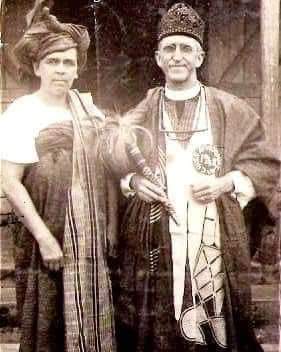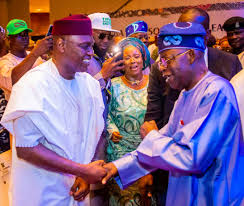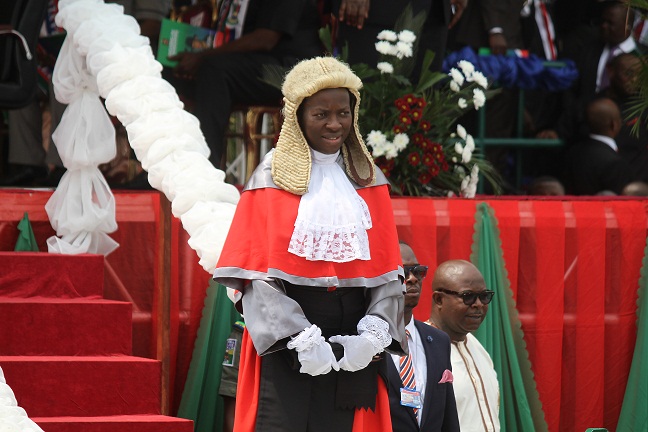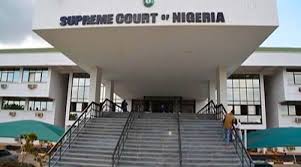How I established Christ School, one of Nigeria’s best secondary schools

CHRISTS SCHOOL, ADO EKITI IS NOW 90 YEARS OLD
By Henry Dallimore
Posted by Irohinoodua here is the Arch Dallimore’s last interview as conducted by late Professor Adelola Adeloye
I sat quietly in my place on that morning train from London to Bestil-on- Sea, thinking about my forthcoming meeting with Archdeacon Henry
Dallimore.
It was October 8, 1969.
I was passing through England at that time
and I had written to the Dallimores expressing a desire to visit them.
They were thrilled exceedingly by the gesture and wanted very much to
meet me too.
The first appointment fell through because the
Archdeacon was not feeling well and needed some rest. That was on October 7. Mrs. Dallimore had told me in a telephone conversation that I
could visit them on the following day as
long as I did so before lunch hour and did not tire the deacon.
I was not personally known to the Dallimores.
My connection with them was recently by correspondence, and more remotely by virtue of having attended Christ’s School, and which the Archdeacon founded and where I was a member of Dallimore house.
Even then, I was only six months
old in the school when they left Nigeria in 1947 during which time, like the rest of the junior pupils, I could only watch and wonder from a long distance.
I mentally reconstructed what little I could remember of them-the brisk stooping gait of
the Archdeacon, his distinctive nose which lent a uniqueness to his physiognomy; the energetic Mrs. Dallimore superintending the domestic side of our entire student-life and their black car -Anglia – Creeping up the dusty road and twisting up to the Principal’s house on top of the hill.
Two years and two decades have elapsed since then.
I would have to introduce myself to the Dallimores if I must gain their attention.
That I did at about 11.30 a.m. on that October Wednesday at
95, Grange Court Drive,
Bexhill-on-Sea,
It was a quiet country bungalow almost at the end of the curved road.
As I thumbed the door-bell, Mrs. Dallimore came to the door to usher me into the comfort of their house and into the momentous two-hour-period during which I came into contact with
the Dallimores.
‘I am sorry to be late. I missed the train from Victoria and had to wait for another one’, I pleaded.
‘Come right in!’ said Mrs. Dallimore. It was striking that she was still looking very energetic inspite of her years.
‘The Archdeacon was wondering whether I had not given you proper directions in my letter as to how to find our place’, she said.
As I entered the sitting room I was thrilled to see Archdeacon Dallimore himself.He was well-dressed as was his habit during his stay in Christ’s School. He was in his clerical attire – the white collar and the black vestment. His sparse hair was wholly silvery-white and well-groomed in the manner characteristic of the man.
The hearing-aid was on the right side which he turned to me. In his usual soft voice, now
very much mellow with advanced age, he welcomed me to the seat next to him.
He admired my portable tape-recorder and the camera as I got my tape-recorder ready for the
business of the morning. He was delighted that I was able to come, but warned me not to expect too much from him. ‘I’m an old man and my memory not perfect’, he said.
Little wonder then that he could not remember exactly when he arrived in Nigeria and the year he came to Ekiti. Then, the questions:
THE INTERVIEW
•Who gave you the land on which Chris’s School stands ?
The Ewi of Ado-Ekiti decided upon the land
•Why in particular did you choose the name Christ’s School?
As the final and head school of the area, there was no better name I could think of at the time. I chose the name but the school was opened by (Governor Bernard Henry) Bourdillon.
•What purpose did you want the school to fulfil when it was founded ?
To lead Ekiti on to the place it should occupy in the country. There was no source of leadership then in the district and provision had to be made for it. The school is to prepare pupils for this leadership. We could not get Ekiti boys into other schools and
yet they were capable.
•What thoughts did you have before you built the school chapel?
I felt it was necessary to have a central place of worship if the whole school was living in.
•Any disappointments with Christ’s School?
None
•What has pleased you most about the school?’
Everybody had worked together well in the school and in relation to the community.
“What became of your old black car ?
“I don’t know.
•What role did your wife played in the evolution of our school ?
Well, she has always been my right hand person. She was part of a large family at home
•Why did you finally leave Nigeria in 1947?
I’d been wanting to go for sometime to allow a younger man to take over
•What have you been doing since you left Christ’s School?”
When I came home, the Bishop of Liverpool offered me a living in his diocese. I had been in touch with him all along during my
stay in Nigeria.
•The school is now co-educational again as it was when you left in 1947. What do you think about that ?
I’m pleased about that. It requires more thought on the part of the teachers and the society the school is meant to serve.
•What in your opinion is the future of Christ’s School?
•That depends on the staff and the pupils
‘Do you remember in particular any of your old pupils and staff members of the school?*
Here, he went quiet again for an unusually long time.No doubt many names, faces and events long crammed into his mind. As the silence lingered on, I burst in by asking him if he could tell me a bit of his own background.
Archdeacon Dallimore came from a large family in the cotton county of Lancashire, England, where he was horn on February 5, 1885. His parents were simple people, his father kept horses and his mother was ‘a good housewife’.
Young Henry Dallimore went to Ormskirk Boys School in South Lancashire (which he said I cannot find again), and in 1904 entered Liverpool University.
With the outbreak of the First World War in 1914, he came out to Sierra Leone as the Headmaster of a Grammar School there.
He taught in another grammar school in Britain for a period after he returned from Sierra Leone, and later went to the University College of Oxford to train for the Ministry.
He was later ordained in the diocese of Liverpool where he served for three rears.
He made another visit briefly to the Sierra Leone after the First World War to ‘re-establish the Universitv Christian Union which has been broken up by the war’. He left from Sierra Leone to take up appointment as Vice-Principal in St.
Andrew’s College, Oyo, Nigeria where the late Dr. Burton was then the Principal.
He was transferred from Oyo to Ekiti as
the Superintendent of the diocese of Ekiti.
•When were you married?’
1924. At my wife’s home in Norfolk.
•You published some works on geography
I wrote two books on geography, and taught the subject for some time in Christ’s School.
•Finally, I decided to ask him about his contemporary missionaries in Ekiti.
Rev Isaac Babamboni came as an evangelist and helped in organising the C.M.S. in Ekiti at the time..Those were early days. I thought that he might have had this at the back of his mind. A simple man, you know. But he had come to be able to read the bible and to know the love of God.And he wished to preach it, and he did preach it.
•Was he an Ekiti man ?
Yes, that’s what brought him back
•Who was Harding
Rev Harding was the first missionary
•Can you remember him?
No. I did not meet him.He had gone before I came. He was our first missionary, then Hargreaves came.Canon Jebb was there at the time.Short comings and goings, you know
•Who else was there at the time?’
Oh dear.You’ll find this in the books
( Then, Mrs Dallimore came in). She narrated how in the early days as they went for their walk one day, they came to the rocky spot where the old Principal’s house , (Anglican Bishop Court) now stands and she said loud and clear : “This is the place”
She narrated with delight her first meeting with
the late Babamboni, ‘a very determined, grand old man who lived ahead of his time’.
She recalled Babamboni’s youthful
enthusiasm to learn even in the twilight of his days, and told with glee how, one day, Babamboni came into a class where an English lesson was going on and said he would not leave until
he knew ‘this new thing about subject and predicate’.
She talked also about those from Nigeria who had visited them.
Rev. L.D Mason, Dallimore’s successor, had called on them à few times, and Mrs. Ebun Shanu, who was their goddaughter and a member of their family had visited them many times.
Pictures: Courtesy Christ’s School Library
Clockwise: The School’s Main Gate, Governor Bourdillon, Professor Adelola Adeboye, Archdeacon Henry Dallimore & Wife, Dorothy Dallimore




